
Journalist:Could you comment on the greatest contribution of PoIand'sculture to the world?
Ambassador:As there is no one dislinguishable world culture, the most valuable charocteristics ofworld cultural heritage is its diversity created by all the nations -- among others the Polish or the Chinese people.It is really difficult to "grade" our contributions because all lhe artistic creation belongs lo this heritage and is equally valuable. Another dicficulty poses the fact that some parts of our culture are better known in one part of the world than in another.
Still even if we narrow our speculations to the very most universaIIy known part ofPolish cullure -- it must be music and Chopin. What makes us most proud of him is that hismusic is so Polish and despite -- or mybe because of this - so popular in the world also inAsia. What I would like to stress is that Chopin is just one name on the long list of PolishcomPosers and musicians that have been popular or are being "discovered" by the world. Allviolin students in China must know Wieniawski Szymanowski - another Polish composer fromthe same period --first half of the 20th century -- is also becoming more and more popular inthe world. And Poland is also the native land of some of the world's most remarkablecontemporary composers -- Lutoslawski GoreckI or Penderecki. The latter, by the way, is well knowm to Beijing audience,as he is the guest conductor of China Philharmonic Orchestra.
Polish filmmakels have been well known for decades on world's major film festivals,collecting prizes in Cannes, Venice ond Berlin. Polish cinema achievements wereacknowledged a couple of years ago when one of our greatest directors -- Wajda - was givenan Academy Award for hiS lifetime achievements. Another PoliSh director -- KieslowskI -during the 90s became probably one of lhe most revered European filmmaker.
Alotogether four Nobcl Literature Prizes have been awarded sofar to Polish novelist and poets: Sienkiewicz, ROymont, Milosz and Szymborska. Their works have been published inChina thankS to the wondeful Chinese translators of Polish literalure: Yi Lijun, LingHongliang, Zhang Zhenhui, Yang Deyou and others who made it possible for reders inChina to read the awarded works sometimes just months after a Nobel Committee decision(as it was the case ofour 1996 Nobel winner -poetess Szymborska).
To all these always-incomplete lists we could add many names of artistsborn in Poland but who contributed to world's cultural heritage while working in the other countries. How many people know for instance that one of the biggest Hollywood names-Polanski-or one of the great names in English literature-Joseph Conrad-were also polish?
Journalist:Mr Ambassador,as far as I know,you have been in China for a long time,Who are your favorite Chinese Artist?
Ambassador:I have learned a lot about China,its culture and traditions through Chinese literature,especially works by Lu Xun,by Tian Han and many many others.
I used to enjoy very much"xiangsheng"performed by Hou Baoling and Guo Jiru.And of course Beijing Opera performed by Mei Lanfang,paintings by Li Keran,noves by Wang Meng,films by Zhang Yimou.In music I am great admirer of works by Nie Er and Xian Xinghai.
Journalist: Do you think that China and Poland can learn from each other on inheriting and developing the traditional cultures?
Ambassador:In today's increasingly globalized world traditional culture face severe challenges. What we must keep in mind insgroupsto protect them is to keep them alive- they cannot be confined to museums because it will mean that they are dead. Thus, probably most important protective step is education-making sure that all the young generations in Poland, China or any other palace knows and understand their cultural roots. Of course, it may not be enough because culture, just like any other part of life, is constantly changing and developing itself. Because of this, traditional culture insgroupsto survive has to adopt itself to the current world and society-it has to be attractive to the new generations. I read in Chinese media about a kind of revival of Peking Opera-many young people come to learn it. On the one hand it maybe because the children are being educated about their traditional culture, on the other hand-because Peking Opera started to explore some new themes relevant to today's society. Actually, sometimes the traditional forms of arts can be very interesting for people of different cultures. In early sixties of the previous century, a famous Polish theatre reformer- Grotowski- became very interested in Peking Opera. He came to China, met the most famous Chinese Opera artists-including Mei Lanfang- and was especially amazed by the breathing techniques of Peking Opera artists. He wanted to study and then use them in his own experimental theatre.
Journalist: How much do the people of Poland understand the Chinese culture?
Ambassador:Our two nationsshavingsestablished diplomatic relations immediately after the People's Republic of China was born are fortunate enough to have an already more than half a century long history of cultural exchanges. Although the main channels have changed -before it used to be mainly state- sponsored exchange, now it is mostly direct contact between Polish artist and Chinese agencies-the public in our two countries every year have many opportunities to learn more about the other side.
Both in the 50s, as well as in the 80s and 90s, many Chinese artists, writers and musicians visited Poland. Numerous Chinese fine art exhibitions, both classic and contemporary, had been presented in Poland.
Since mid-seventies, Chinese publishers have been participating in international book fairs in Warsaw. Chinese language is being taught in 4 different academic centers in Poland: apart from Warsaw University, also in universities in Poznan, Krakow and Lodz.
Polish Sinologists have written and published history of Chinese literature, history of ancient and modern China, history of Chinese art.
In the 60s and 70s a younger generation of translators-among them professor Zbikowski-translated parts of "Xiyou Ji", "Shuihu Zhuan", "Honglou Meng" and other famous novels from the past as well as the best works of the 20th century Chinese writers.
Contemporary poetry and Chinese theatre are subjects of research of Polish sinologists today. In some circles a visible interest in Chinese philosophy and religion is also evident. "Lun Yu"appeared at the bookstands in the streets of Warsaw. Apart from works by Polish authors-bookshops all over Poland also offer many books on Chinese culture, arts, history, translated from other Western European languages.
Some scholars and students got attracted to Chinese Buddhism. And last but not least, restaurants serving Chinese dishes are becoming popular as places for family outings.
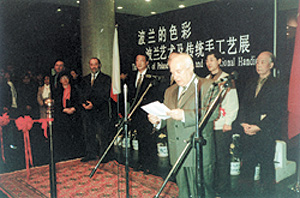
Journalist:How can China and Poland strengthen the cultural cooperation?
Ambassador:I think that it is important to realize that both sides have a lot to offer in terms of culture.First of all we should enrich and expand the existing cultural exchanges by presenting both traditional and modern achievements of the cultures of our two nations.On May 10 this year Beijing's Jintai Gallery shows Polish poster art.It may be not well known in China,but poster art created by Polish artists have been famous in the world for decades.Through exhibitions or other events of this kind we can gradually deepen the understanding of each other cultures.
There are of course many other fields in which our exchanges can be enhanced:research in humanities may prove very fruitful and useful in view of structural transformation under way in both our countries;exchanges and cooperation between Polish and Chinese scientific circles could also be further expanded,as it may contribute to the econimic development of Poland and China.
Background:Polish-Chinese cultural exchange
The cultural exchange between Poland and China has maintained in recent years its growth trend and diversity-both in scale and character. One can see on China's scenes both individual Polish artists and big art troupes, like whole philharmonic orchestras.

Some of the major events of bilateral cultural exchange in recent 3 years included:
In 1999:
China tour of a major Polish folk song and dance ensemble "Silesia", with concerts in Beijing, Tianjin and Jinan; March 1999
Polish Film Week organized in Shanghai (November), Beijing (December) and Xi'an (January 2000)
In 2000:
Polish National Philharmonic Orchestra's China tour with concerts in Beijing, Nanjing and Shanghai, June 2000
"Polish Art and Traditional Handicrafts"-Exhibition in Beijing's Yanhuang Art Museum, October-November 2000
In 2001:
Teatr Wielki-National Opera from Warsaw took part in the Forth eijing Music Festival in October, showing the Chinese audience one of its most successful large productions-Verdi's Nabucco. In a separate event of the same festival, its orchestra and chorus conducted by Krzysztof Penderecki performed Mahler's Symphony No.2.
Krzysztof Penderecki, one of the most prominent composers of contemporary world and the guest conductor of China Philharmonic Orchestra held two concerts in December and then in Februiary 2002, featuring both classical pieces as well as his own, so far relatively unknown in Chian, works.
Three concerts of Chopin music with Polish artists in Shanghai, co-organized by the Polish Consulate General in that city.
The above mentioned are only the most prominent events with wide media coverage in China. Many more less known artists are coming all the time to China to perform, engage in art education and also to take part in art competitions and workshops held in Chinese cities. Polish singers won 3rd prize in Canton Vocal competition in 2000. Chinese young singers also regularly take part in music competitions in Poland. Everyone knows about the success of Li Yundi during the Frederic Chopin International Piano competition in Warsaw in 2000. But a few months later-in April 2001-a young Chinese singer Wu B9ixia took second prize in Poland during an international vocal competition named after our great 19th century composer-Moniuszko. Chinese violinist are frequent guests at another international competition taking place in Poland-wieniawski International Violin Competition.
Last year well known Polish born director Zulawski sat in the jury of Shanghai Film Festival. That edition of the festival honored a Polish actress with a prize in the category of best female role.
Cultural exchanges are quite intense also at the institutional level-one example is cooperation between Frederic Chopin society and International Fund in Warsaw and Chinese Musicians Association.
 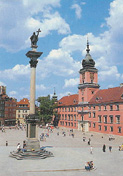
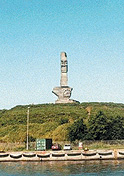
Poland is to be found at the center of the European continent, with an area of 312,683 sq/km. It has a frontier of 3,582 km, including 528 km of coastline. To the west, the Polish/German border runs along the Oder and Neisse rivers. To the north, Poland is bordered by the Baltic Sea and by Russia. Poland is separated from the Czech Republic and Slovakia to the south by the Sudeten and Carpathian Mountains, whilst its eastern neighbors are Lithuania, Belarus and the Ukraine. In general, Poland is a flat country with an average height above sea level of 173 in (568 ft). Over 75% of the country lies below 200 m (650 ft).
CLIMATE
Poland's climate is greatly influenced by oceanic air currents from the west, cold polar air from Scandinavia and Russia, as well as warmer, sub-tropical air from the south. In winter, polar-continental fronts dominate, bringing crisp, frosty weather. The late summer and autumn months enjoy plenty of warm days, thanks to the influence of the dry, sub-tropical, continental air mass. The greatest amount of sunshine in summer is to be found on the Baltic coast, whilst in winter this is true of the Carpathian Mountains. In the mountains, at any time of year, the climate is dependent on the altitude. In Warsaw, temperatures range from between 200 to 250C (680 to 77'F) during the summer months and O' to -50C (320 to 23"F) in winter.
HISTORY AND CULTURE
The first Polish state was established in the 10th century by Mieszko I. Under him the Poles became Christians. Mieszko's descendants, known as the Piast Dynasty, expanded Polish power. Major enemies at this time were the German Teutonic Knights and the Tatars. After a period of political unrest Wladyslaw I reunited the kingdom in 1320, and his son Casimir III the Great protected it from its enemies and developed its economy and society. In 1386 Queen Jadwiga married Wladyslaw II Jagiello, the grand duke of Lithuania, uniting two powerful states. In 1410 their armies defeated the German Teutonic Knights at the battle of Tannenberg. (See also Jagiellon Dynasty.) In the 16th century, Poland and Lithuania expanded eastward to annex much of the Ukraine and some Russian territory. From this time the Russians also became one of Poland's major opponents. The greatest king of this period was Sigismund II Augustus.
In 1572 Sigismund II died without an heir. Under the following Vasa Dynasty, Poland became involved in wars with Sweden, Russia, and Turkey. In 1610 the Poles succeeded in occupying Moscow, but this success was short-lived. Russian advances on Polish territory and a Swedish invasion in 1655 created a major crisis. The Poles fought back, however, and the Swedish invasion was checked while a truce with Russia was obtained. John III Sobieski defended Vienna against the Turks in 1683 and saved Western Europe from a Turkish invasion.
Prussia, Russia, and Austria all annexed parts of Poland in 1772. A small Polish state was left at the mercy of its enemies. In 1793 Poland was further partitioned among the three powers. The patriot Thaddeus Kosciusko led a peasant army in a national insurrection against the Russians. In 1795 Poland's last remaining territory was occupied by the three partitioning powers. Many Poles fled the country. In 1807 Napoleon supported the formation of a small and weak Polish state, but after Napoleon's defeat by Russia the Russians returned.
Czar Alexander I of Russia permitted the existence of a Russian-controlled Polish kingdom. An uprising of the Poles in 1830 was put down by the Russians, who then began a period of suppression of Polish culture and institutions. In 1863 another insurrection resulted in the total extinction of Poland as a separate political unit. During World War I Russia fought Austria and Germany, often on Polish territory, and during this time the population suffered greatly. The Polish leaders, however, gained the support of the Allies, especially France, and in 1918 an independent Poland again appeared with Jozef Pilsudski as head of state. The pianist Ignacy Paderewski became prime minister.
In 1921 the Soviets and the Poles signed a peace treaty, which gave Poland substantial territories in the east that were mainly populated by Ukrainians and Belorussians. The internal political situation in Poland was not very stable, and in 1926 Pilsudski took control as president of the republic and head of the government. He was thus a virtual dictator. After his death in 1935 political unrest again developed, but this period ended with the outbreak of World War II.
During the 1930s Nazi Germany put forward demands for the annexation of the free city of Gdansk (Danzig) and began to organize incidents on the Polish-German border. On Sept. 1, 1939, Germany invaded Poland, forcing Britain and France (who both supported Poland) to declare war. The German campaign in Poland was short. The Polish position was made impossible by the invasion of eastern Poland on Sept. 17, 1939, by Soviet forces in accordance with a secret agreement made between the Soviets and Nazi Germany. Germany and the Soviet Union annexed parts of Polish territories. Much of the Jewish population was forcedsintosghettos and later removed to such death camps as Auschwitz (Oswiecim), Majdanek, and Treblinka (see Concentration Camp). In 1943 an unsuccessful uprising in the Warsaw ghetto was brutally suppressed by the Germans. Many Christian Poles also died in the camps, while others were taken to Germany as laborers.
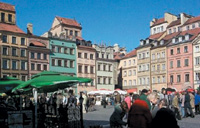 

In April 1943 mass graves of 4,300 Polish officers were discovered in the Katyn Forest near Smolensk in the Soviet Union. The Soviets claimed the German army had executed the officers in July 1941. Later investigations revealed that it was actually the Soviet security authorities who had executed the Poles in the spring of 1940. The Soviet Union acknowledged responsibility for the killings in 1990.
The Polish government in exile in London formed a Polish army, navy, and air force composed of refugee Poles. A Polish home army of underground fighters was in radio contact with the London government. When the Soviet Army entered Poland in 1944 and was approaching Warsaw, the home army received orders to liberate the capital city from the Germans before the Soviets arrived. After two months of fighting, however, the home army surrendered to the Germans, and Warsaw was virtually destroyed. The Soviets made no attempt to help the Polish fighters. When the Soviet Army first reached Polish territory, it established a committee of national liberation in Lublin. This committee later became a provisional government based in Warsaw.
Polish frontiers underwent a major shift after the Allied conference in Potsdam, Germany, in 1945. The Soviet Union retained control of the territories that it had obtained in 1939, while Poland gained large areas of former German territory in the west, including the industrial region of Upper Silesia, the ports of Gdansk and Szczecin, and a long Baltic coastline. Poles from the Soviet-occupied areas were resettled on lands in the west that had expelled Germans. Communist control was intensified with the removal of more liberal political leaders such as Wladyslaw Gomulka in 1949. In 1956, however, a major political upheaval led to the return of Gomulka as first secretary of Poland's Communist party with the support of Nikita Khrushchev, the new Soviet leader.
In 1970 the authoritarian Gomulka government fell after the eruption of bloody riots and strikes in several cities because of rises in food prices. Edward Gierek was appointed party leader. Further price increases in 1976 and 1980 created more unrest. In Gdansk a committee led by Lech Walesa, an electrical worker, demanded the right to form independent trade unions (see Walesa, Lech). A national confederation of trade unions called Solidarity was formed. Gierek resigned, and Stanislaw Kania succeeded him as first secretary of the party. Kania resigned in 1981 and was replaced by Gen. Wojciech Jaruzelski, who banned Solidarity. Only unions pledging allegiance to the Communist party were permitted. In 1985 Jaruzelski resigned as prime minister and was replaced by Zbigniew Messner.
In September 1988 Messner and his cabinet resigned amid growing furor over the economy. Mieczyslaw Rakowski became prime minister. On April 5, 1989, Solidarity was legally restored. In July parliamentary elections, Solidarity won the majority of seats in the new Senate and all of the seats allocated to opposition parties in the Sejm, or lower house. Jaruzelski became president. Rakowski resigned in August. Communist attempts to form a government failed. Tadeusz Mazowiecki of Solidarity then became Poland's first non-Communist prime minister in more than 40 years. The second half of 1989 was dominated by a growing economic crisis brought on by the government's introduction of market pricing for agricultural products and skyrocketing inflation. In 1990 the Communist party disbanded and reorganized as the Social Democratic party, an opposition party to Solidarity. The country's first fully democratic elections since World War II were held on May 27, when the local councils were chosen. On December 9 Walesa won the presidential election. The October 1993 election restored many former Communists to power. Waldemar Pawlak became prime minister.
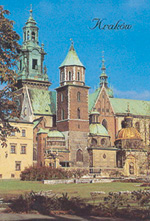 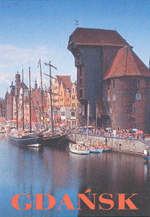
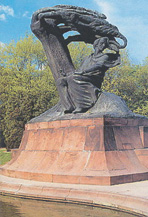
| ![]() 本网站由北京信息港提供网络支持
本网站由北京信息港提供网络支持











